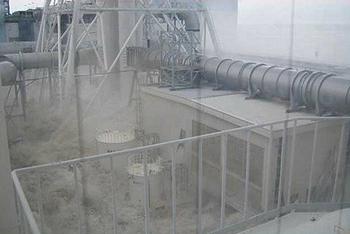
HUELVA, Spain, September 24, 2012 (ENS) – Twenty-three nuclear power plants with 74 reactors are located in areas of the world that are at high risk of large tsunamis, finds new research from scientists in Spain and Belgium.
Giant waves touched off by earthquakes, tsunamis are synonymous with the destruction of cities and homes. They can cause meltdowns at nuclear power plants, as shown by the earthquake and tsunami off Japan’s Pacific coast in March 2011 that caused the world’s second worst nuclear accident at the Fukushima Daiichi power plant.

China is making a massive nuclear investment, building 27 of the 64 nuclear reactors currently under construction in the world. “The most important fact is that 19, two of which are in Taiwan, out of the 27 reactors are being built in areas identified as dangerous,” say the study’s authors.
“The location of nuclear installations does not only have implications for their host countries but also for the areas which could be affected by radioactive leaks,” said Joaquín Rodríguez-Vidal, lead author of the study and researcher at the Geodynamics and Paleontology Department of the University of Huelva in Spain.
In the study, published in the journal “Natural Hazards,” the researchers drew a map of the world’s geographic zones most at risk of large tsunamis and identified “potentially dangerous” areas where completed nuclear plants or those under construction are sited.
Of these, 13 plants with 29 reactors are in active operation. Another four, that now have 20 reactors, are being expanded to house nine more; and there are seven new plants under construction with 16 reactors.
Professor Rodríguez-Vidal recommends more local analyses that consider the seismic amplification of each nuclear power plant to determine what eachinstallation identified in the study must do to strengthen its fortifications and tsunami response.
As earthquakes and tsunamis are difficult to predict, the authors used historical, archaeological, geological and instrumental records as a base for determining tsunami risk, explained Manuel Rodríguez-Llanes, coauthor of the study and researcher at the Centre for Research on the Epidemiology of Disasters, CRED, of the Catholic University of Leuven in Belgium.
“We are dealing with the first vision of the global distribution of civil nuclear power plants situated on the coast and exposed to tsunamis,” Rodríguez-Llanes told the Scientific Information and News Service, SINC, based in Spain.
The risk of these natural disasters threatens nearly the entire west coast of the United States, the Spanish/Portuguese Atlantic Coast and the coast of North Africa.
At even greater risk, due to the presence of atomic power stations, are the Eastern Mediterranean and South Asia and Southeast Asia.
In Japan, there are seven plants with 19 reactors at risk, one of which is currently under construction. But the Japanese government declared earlier this month that the country would phase out all nuclear power plants by sometime in the 2030s.
South Korea is now expanding two nuclear power plants at risk with five reactors.
India, with two reactors, and Pakistan, with one reactor, could also feel the consequences of a tsunami at these facilities.
Debarati Guha-Sapir, a CRED researcher and study co-author, said, “The impact of natural disaster is getting worse due to the growing interaction with technological installations.”
According to the study, we should learn our lessons from the Fukushima accident and also from the undersea earthquake that struck December 26, 2004, with an epicenter off the west coast of Sumatra, Indonesia. It triggered a series of devastating tsunamis that inundated Indian Ocean coastlines, killing over 230,000 people in 14 countries, and flooding coastal communities with waves up to 30 meters (98 ft) high.
For the authors, prevention and previous scientific studies are the best tools for avoiding such disasters. “But since the tsunami in 2004 the Indian Ocean region is still to take effective political measures,” warn the researchers.
The Fukushima Daiichi nuclear crisis took place in a highly developed country with one of the highest standards in scientific knowledge and technological infrastructure, the authors point out. “If it had occurred in a country less equipped for dealing with the consequences of catastrophe, the impact would have been a lot more serious for the world at large.”
Copyright Environment News Service (ENS) 2012. All rights reserved.
© 2012, Environment News Service. All rights reserved. Content may be quoted only with proper attribution and a direct link to the original article. Full reproduction is prohibited.
